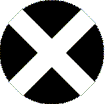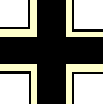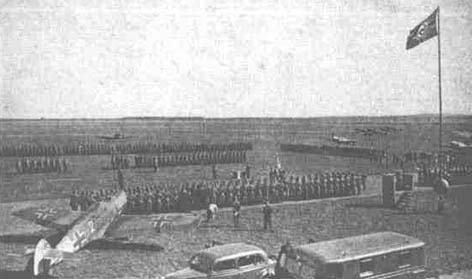Spain


Arístides García López Rengel
Spain


Arístides García López Rengel
– 27 November 1941
Arístides García López Rengel was an auxiliary sargento piloto trained to fly fighters and light bomber aircraft pre-war.
During his advanced military training in 1934, García López was classmate with Felipe del Río Crespo and Manuel Izquierdo. Together with these, he took part in the Spanish Vuelta Aérea (Air Tour).
Mobilising in support of the military rebels in Andalusia and sent to Tablada, Arístides García López flew Breguet XIXs that still bore Republican tricolour markings on the Granada front until he was shot down in error by a Ni-H.52 on 7 August. Fortunately, Garcia Lopez and his observer/rear gunner escaped unhurt.
On 1 January 1937, sargento García López was shot down for a second time when his Breguet XIX was hit by Republican anti-aircraft fire near Porcuna, which had been occupied by Nationalist forces that same day.
Crash-landing in enemy territory, García López managed to escape capture by walking back across the battlefield.
He joined Escuadrilla 2-E-2 after being promoted to alférez provisional, this unit being equipped with He 51s.
It had been formed at Seville in February 1937 under the command of capitán Ángel Salas.
On 16 April, over the Teruel front, alférez García López of 2-E-2 downed an SB bomber from Grupo No 12 near the Nationalist airfield of Calamocha.
This was the one and only time that a pilot flying a He 51 managed to bring down a SB, as the latter was considerably faster than the German biplane fighter.
The all-Spanish Fiat Grupo, with the designation 2-G-3, was formed in Cordoba on 4 May from the escuadrillas led by capitán Joaquín García Morato and capitán Ángel Salas (2-E-3). Morato assumed command of the Grupo, and Julio Salvador took over leadership of Morato’s old escuadrilla (1-E-3).
This had been made possible after a further consignment of eight CR.32s had been passed on to the Nationalist air force in April 1937, and they joined the five previously handed over four months earlier to form the basis of the first Spanish grupo equipped with Fiat fighters. Grupo 2-G-3 consisted of 13 aircraft and 15 pilots, which were divided into two escuadrillas of six fighters each. The final CR.32 was Morato’s personal (3-51).
Of the pilots assigned to its escuadrillas, two of them had previously served as wingmen in the Patrulla Azul, while the remaining 12 were chosen according to their experience in fighters.
Escuadrilla 1-E-3
Teniente Julio Salvador (CO)
Teniente Miguel Guerrero García
Alférez Manuel Vázquez Sagastizábal
Alférez García López
Alférez Rafael Mazarredo Trenor
Alférez Jesús Rubio Paz
Brigada Ramón Senra ÀlvarezEscuadrilla 2-E-3
Capitán Ángel Salas
Capitán Narciso Bermúdes de Castro
Capitán Javier Murcia Rubio
Teniente Miguel García Pardo
Alférez Javier Allende Isasi
Alférez Joaquín Ansaldo Vejarano
Alférez Jorge Muntadas Claramunt
During the morning on 30 December, 15 CR.32s from Grupo 2-G-3 and three from Escuadrilla 3-E-3 (the latter undertaking its first combat mission) took off from Alfamén and intercepted 17 I-16s from Escuadrillas 5a and 6a of Grupo No 21. Two Ratas were credited to capitán Javier Murcia Rubio (3-E-3) and alférez García López (1-E-3), the latter also subsequently claiming a ‘Martin bomber’ destroyed. Leitenant Aleksandr Mikhailovich Sumarev of 6a/21 was indeed killed in action, and two of his comrades returned to base wounded. All seven surviving I-16s from 6a/21 had suffered combat damage.
It's possible that Konstantin Dobronitskiy from 5a/21 took part in this combat. Some sources claim that his I-16 CM-132 was damaged in combat with CR.32s while other claim that his I-16 was hit by AAA fire. On trying to land it seems that he hit a tree (or wall) and he suffered a severe head trauma.
Around midday on 24 March 1938, 18 Fiats from all six Spanish CR.32 escuadrillas led by capitán Ángel Salas provided escort for the He 51s and SM.79s attacking Quinto. Between Quinto and Farlete they encountered eleven Ratas and 30 Chatos. In the ensuing combats four Chatos were claimed; capitán Salas, alférez García López (1-E-3), brigada Ramón Senra Àlvarez (1-E-3) and Rúiz Jiménez each claiming one. Teniente José Jurado González (3-E-3), flying Fiat No 3-104, was killed in action when Republican fighters shot him down between Caspe and Quinto.
Legion Condor Bf 109s also joined the fray, while He 51s flown by Spanish pilots performed ground attack missions below the swirling dogfight and one of the He 51s were destroyed, although its pilot survived.
At the end of this air battle, Salas almost succeeded in capturing a Chato. He had attacked one of the enemies and, although unable to destroy the machine, he so clearly held the upper hand that the Chato pilot descended to a low altitude and was making for Nationalist lines, with Salas in close attendance. Just as the Chato was about to land, it was attacked by a Bf 109B (No 51) flown by Oberleutnant Wolfgang Schellmann, staffelkapitän of 1.J/88, and destroyed, prompting Salas to lodge a formal complaint with the Legion Condor.
The German Bf 109s from 1.J/88 claimed two more I-15s in this combat when Leutnant Fritz Awe and Unteroffizier Alfred Stark claimed one I-15 each.
Totally the CR.32 pilots claimed four I-15s and five probable and the Bf 109s were credited with three I-15s.
In this battle Government aircraft Nos. CA-006, CA-032, CA-037 and CA-052, piloted respectively by Antonio Sánchez, Benigno Domingo Hueso, Jesús Pérez Pérez and Fernando Villins León, were destroyed and the pilots KIA; teniente Francisco Viñals Guarro and Elías Hernández flying machines Nos. CC-030 and CC-027 collided; and Alfredo Dealbert, aircraft No. CA-038 force-landed outside the airfield.
Teniente Viñals of the 2a/26 had sortied from Pomar de Cinca airfield and he bailed out and landed between Pina and Osera.
The Government Air Force had not previously lost so many aircraft in a single battle.
The Escuadra de Caza No 11 claimed four CR.32s and one Bf 109 with one CR.32 and one He 51 as probably destroyed.
During a second sortie of the day on 19 June, ten Fiats of 2-G-3 took off at 18:00 led by capitán Ángel Salas, to escort Ju 52/3ms bombing La Puebla de Valverde. They encountered a formation of 18 Chatos, which they chased as far as Alcublas, where nine Ratas joined the fray. Capitán Salas dived over the Chatos to attack, but was unable to fire his guns because a leak had emptied his compressed air bottle. Despite this, he continued to make dummy attacks, being hit five times by the Ratas, one bullet puncturing the coolant radiator. Teniente Julio Salvador (CO 1-E-3) enjoyed better luck, bouncing two Chatos from above near La Puebla, one of which exploded in the air, the other following in flames. It seems that these come from the 3a Escuadrilla and both pilots survived with wounds. Salvador then had to retire with an overheating engine. Teniente Miguel García Pardo (2-E-3) effectively removed a Rata from the tail of alférez Arístides García (1-E-3) Fiat by shooting it down. Teniente de Hemricourt (2-E-3) downed a Chato near Alcublas, then a Rata to the north of Villar del Arzobispo, and saw a Chato turn somersault as it attempted to land at its aerodrome. Teniente Esteban Ibarreche fired at a Chato close to the ground, and this separated from the rest of the formation and fell near to Hiruerela. Alférez Joaquín Ansaldo Vejarano (2-E-3) had to return to base when an engine cowling parted company from his Fiat.
No CR.32s were lost in this combat.
At the start of the Valsequillo Offensive on 5 January 1939, the only CR.32 unit in Andalusia at the time was Escuadrilla 8-E-3 (led by García López) at Posadas, near Cordoba. One week later it was joined by 1-E-3 and 3-E-3 Escuadrillas (led by capitán Manuel Vázquez Sagastizábal and capitán Miguel Guerrero García, respectively), which were transferred in from Aragon.
On 9 February, five I-15s were claimed by Spanish pilots near Peñarroya, in Andalusia. Two were credited to capitán García López (8-E-3), taking his overall tally to 17, and one each to Juan Frutos Rubio, teniente Antonio Manrique (1-E-3) and teniente Luis Alcocer - the latter two pilots each ‘made ace’ with these successes.
This was the last aerial combat for the CR.32 in Spain
García López ended the Spanish Civil War with 17 biplane victories.
He was the only one of the top five Spanish pilots to have started the war as a non-commissioned officer - a rank more usually seen in the Republican forces.
In June 1941, he was awarded the Medalla Militar (Individual Military Medal) for the courage he had displayed during the Spanish Civil War.
However, Garcia López was posted missing in action prior to the presentation ceremony planned for 10 December that same year.
He volunteered for combat in Russia and served in the 1a Escuadrilla Azul, (Escuadrilla Expedicionaria) which was formed with 17 pilots. Some of them were veterans of the Spanish Civil War and had a combined score of 79 aerial victories.
The unit crossed into France on 24 July 1941, later arriving in Germany in late part of the month.
They were assigned to training at the Jagdfliegerrschule 1 at Werneuchen near Berlin.
After completing their training on Bf 109 Es, the 1a Escuadrilla left for Russia on 26 September.
At first the Spanish pilots were worried that they would arrive late to see any action, since they were kept informed of the progress of the German advance towards Moscow.

The 1a Escuadrilla received a total of 12 Bf 109 E-4s and –7s and they were assigned to JG 27, VIII FliegerKorps of LuftFlotte 2. They were known as the “15 Spanische Staffel”, and they were structured into three påatrols, with five pilots each and a staff:
Staff: CO commendante Ángel Salas and second in command commendante José Muñoz Jiménez.
1st Patrol: capitán García López and tenientes Alfonso Rubial, Ángel Mendoza, Ricardo Bartolomé and Abundio Cesteros.
2nd Patrol: capitán Javier Allende and tenientes Luis Alcocer, José Lacour, Javier Busquets and Alfonso Gracia-Rodriguez.
3rd Patrol: capitán Carlos Bayo and tenientes Esteban Ibarreche, Emelio O’Connor, Manuel Kindelán and Demetrio Zorita.
The Spanish unit started to fly their first combat operations on 2 October 1941. Escorting German bombers and reconnaissance aircraft, they operated from 12 different airfields.
On 27 November, while serving as a patrol leader with the Bf 109 E-equipped 1a Escuadrilla de Caza Expedicionaria en Rusia, he failed to return from a patrol over the Moscow front.
At the time of his death, García López was credited with 17 biplane victories.
Claims:
| Kill no. | Date | Time | Number | Type | Result | Plane type | Serial no. | Locality | Unit |
| 1937 | |||||||||
| 1 | 16/04/37 | 1 | SB (a) | Destroyed | He 51 | near Calamocha airfield | 2-E-2 | ||
| ? | 30/12/37 | morning | 1 | I-16 (b) | Destroyed | CR.32 | Teruel area | 1-E-3 | |
| ? | 30/12/37 | morning | 1 | SB (b) | Destroyed | CR.32 | Teruel area | 1-E-3 | |
| 1938 | |||||||||
| ? | 24/03/38 | midday | 1 | I-15 (c) | Destroyed | CR.32 | Quinto area | 1-E-3 | |
| 1939 | |||||||||
| 16 | 09/02/39 | 1 | I-15 (d) | Destroyed | CR.32 | near Peñarroya | 8-E-3 | ||
| 17 | 09/02/39 | 1 | I-15 (d) | Destroyed | CR.32 | near Peñarroya | 8-E-3 |
Biplane victories: 17 destroyed.
TOTAL: 17 destroyed.
(a) SB from Grupo No 12 shot down.
(b) Claimed in combat with 5a/21 and 6a/21, which lost 1 I-16 and 7 damaged. 2-G-3 and 3-E-3 claimed 2 I-16s and 1 SB.
(c) The Nationalist side claimed seven I-15s (4 by Spanish CR.32s and 3 by 1.J/88) while losing one CR.32 and one He 51. The Government admitted the loss of 6 and 1 force-landed while the Escuadra de Caza No 11 claimed four CR.32s and one Bf 109 with one CR.32 and one He 51 as probably destroyed.
(d) Five I-15s were claimed by Spanish pilots. These were the last CR.32 claims in Spain.
Sources:
Air Aces - Christopher Shores, 1983 Presidio Press, Greenwich, ISBN 0-89141-166-6
Air War over Spain - Jesus Salas Larrazabal, 1974 Ian Allan Ltd, Shepperton, Surrey, ISBN 0-7110-0521-4
Fiat CR.32 Aces of the Spanish Civil War - Alfredo Logoluso, 2010 Osprey Publishing, Oxford, ISBN 978-1-84603-983-6
Joaquin Garcia-Morato - Best Ace of Spanish Civil War (WWII Ace Stories) - Mihail Zhirohov, 2003
Spanish Republican Aces – Rafael A Permuy López, 2012 Osprey Publishing, Oxford, ISBN 978-1-84908-668-4
The Legion Condor - Karl Ries and Hans Ring, 1992 Schiffer Publishing, ISBN 0-88740-339-5
Wings Over Spain - Emiliani Ghergo, 1997 Giorgio Apostolo Editore, Milano
Additional information kindly provided by Alfredo Logoluso and Ondrej Repka.


